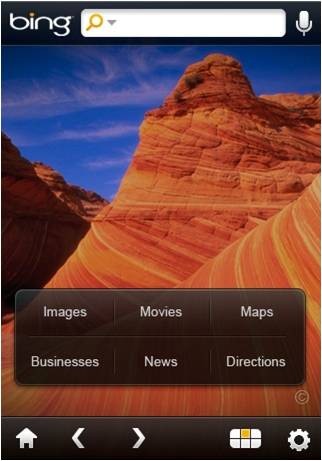 Do we smell cooperation? Almost. It actually smells more like toleration. Friendly feuding companies Apple and Microsoft got a little closer this week thanks to the Bing iPhone app. Microsoft’s Bing app was approved by Apple and is ready for download to the iPhone and iPod touch at Apple’s App Store. The app, which is completely free, supports straight Web searches, provides search suggestions, displays the Bing image of the day, and supports other specialized features from Bing, such as images, videos, maps, business locations, and news.
Do we smell cooperation? Almost. It actually smells more like toleration. Friendly feuding companies Apple and Microsoft got a little closer this week thanks to the Bing iPhone app. Microsoft’s Bing app was approved by Apple and is ready for download to the iPhone and iPod touch at Apple’s App Store. The app, which is completely free, supports straight Web searches, provides search suggestions, displays the Bing image of the day, and supports other specialized features from Bing, such as images, videos, maps, business locations, and news.
Microsoft has been pretty serious about its Bing search engine, promoting it in just about any mobile space or platform it comes across—even a free app for the iPhone. It almost looks like one of the signs of the Apocalypse, but surprisingly it’s not and surprisingly the app seems pretty useful—and it’s not from Google, so we can understand the appeal. The app is basically “Bing,” but in app form—it’s like a mini mobile Bing. Microsoft’s Voice Search function has been integrated into the mobile mapping application, which also uses Microsoft’s Seadragon technology. The app also allows Bing to tap into the iPhone’s GSP, which can locate users, and will return locally relevant search results when you’re seeking places such as restaurants, banks, or theaters. Bing will also provide either driving or walking directions to those places.
Bing is already available for BlackBerries, Windows Mobile phones and other mobile browsers, and it works with any iPhone or second-generation iPod touch running iPhone OS 3.0 or later.
Editors' Recommendations
- An Apple insider just revealed how iOS 18’s AI features will work
- 5 phones you should buy instead of the iPhone 15
- iPhone 16: news, rumored price, release date, and more
- iPhone SE 4: news, rumored price, release date, and more
- 3 reasons why I’ll actually use Anker’s new iPhone power bank


